| Eurovision Young Dancers | |
|---|---|
 | |
| Also known as | Eurovision Competition for Young Dancers |
| Genre | Dance contest |
| Country of origin | List of countries |
| Original language | English |
| No. of episodes | 15 contests |
| Production | |
| Production locations | List of host cities |
| Running time | 90 minutes (2011–2017) |
| Production company | European Broadcasting Union |
| Original release | |
| Release | 16 June 1985 – 16 December 2017 |
| Related | |
| Eurovision Song Contest Eurovision Young Musicians | |
Eurovision Young Dancers (French: L'Eurovision des Jeunes Danseurs), often shortened to EYD, or Young Dancers, was a biennial dance competition, organised by the European Broadcasting Union (EBU) and is broadcast on television throughout Europe. Thirty-seven countries have taken part since the inauguration of the contest in 1985; including Kosovo (a non-EBU member) and Canada (a North American country).
Performers between the ages of 16 and 21, from member countries of the European Broadcasting Union, compete as solo of couples to dance routines of their choice. Professional jury members each representing the elements of ballet, contemporary, and modern dancing, score each of the performances. The two participants which receive the most overall points advance to a televised 'dance-off' final, where the winner is decided by the jury.
Spain is the most successful country in the Young Dancers competition, having won five times 1985, 1991, 1993, 1995, and 1997 respectively but has never hosted. On 16 December 2017, the fifteenth and most recent edition took place in Prague, Czech Republic and was won by Paulina Bidzińska of Poland, with Patricija Crnkovič of Slovenia placing second (runner-up).
History
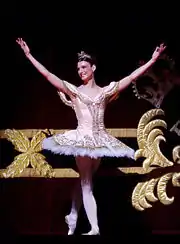
Young Dancers takes place every two-years, in parallel to its counterpart, Eurovision Young Musicians (another EBU biennial youth competition).[1] The inaugural Eurovision Young Dancers contest, then known as Eurovision Competition for Young Dancers, took place in Reggio Emilia, Italy, on 16 June 1985.[2] Eleven countries who are members of the European Broadcasting Union (EBU) competed in the début contest. Spain won the first edition in 1985, represented by Arantxa Argüelles. Norway, represented by Arne Fagerholt, and Sweden, represented by Mia Stagh and Göran Svalberg, came second and third respectively.[3]
A total of thirty-seven countries have competed at least once since 1985.[4] Canada is the only non-European country to have taken part in the contest (as well as the only country in North America to have ever participated in a Eurovision event), although their broadcaster, Canadian Broadcasting Corporation (CBC), is an associate member of the EBU.[5] Eurovision Young Dancers is also the only Eurovision event to feature a country whose broadcaster is neither a full nor associate member of the EBU, as Kosovo made their sole appearance in 2011 (although they have broadcast other Eurovision events for many years). Bulgaria's debut and only appearance in 1991 also marked the first participation of a former Warsaw Pact country in a Eurovision event, as well as the longest gap between a country's debut at another Eurovision event prior to appearing at the Eurovision Song Contest (with fourteen years separating their Young Dancers debut and their Song Contest debut).
In the entire history of the event, only three contests (2007, 2009 and 2019) have never occurred. The 2007 Eurovision Young Dancers competition was cancelled to allow the Prix de Lausanne, a similar event organised by Swiss broadcaster SRG SSR idée suisse to take place at the same venue. The decision to cancel the contest was mutually agreed between the host broadcaster and the EBU.[6] The following contest was due to be held on 19 June 2009 at the Dance House in Oslo, however was eventually cancelled due to a lack of interest from broadcasters.[7] The contest would eventually be held again in 2011 when the format was revived as a prime time show.[8]
On 23 January 2017, the EBU announced that Maltese broadcaster Public Broadcasting Services (PBS), who agreed to host the event in July 2015, had been forced to cancel their staging of the competition. The EBU also stated it was looking for another host broadcaster but should one not be found in time the competition would not take place this year and is expected to return in 2019.[9] On 18 May 2017, Czech broadcaster Česká televize (ČT) confirmed that they would host the contest for a second time.[10]
On 20 December 2018, the contest was cancelled due to the absence of a broadcaster willing to host the competition. As of that time, Malta and Poland were the only eligible countries to have confirmed their intention to participate in the contest.[11] In October 2020, the EBU ruled out bringing the contest back until further notice.[12]
Format
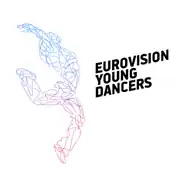
The format has been roughly the same since the 1985 inauguration of the competition. All competing dancers are to be non-professional and between the ages of 16–21. Participants may consist of solo or couples, with each performing a dance routine of their choice, which they have prepared in advance of the competition. All of the acts then take part in a choreographed group dance during 'Young Dancers Week'.[13]
From 1989 to 2003, a semi-final round took place a few days before the Contest, and the jury decided as well which countries qualified for the televised final. In the 2003 contest, the professional jury voted electronically, immediately following each act, awarding points for technique and artistry. For the 2005 contest, the traditional format was changed. A week of dance master classes replaced the semi-final round. Florence Clerc, Irek Mukhamedow, Christopher Bruce and Piotr Nardelli were the dance teachers selected to work with the participants and tasked to select the 10 finalists out of the 13 participating countries.
In 1989 and 2003, the contest awarded two sets of first prize, one for classical and one for contemporary dance. An additional "Youth Jury" prize was awarded in 2003 chosen by a panel of dance enthusiasts in the audience.
The format is revamped in 2011 to include a 'final duel' round and the semi-finals are removed due to the low number of participating countries. Jury members of a professional aspect and representing the elements of ballet, contemporary, and modern dancing styles, score each of the competing individual and group dance routines. Once all the jury votes have been counted, the two participants which received the highest total of points progress to a final round. The final round consists of a 90-second 'dual', were each of the finalists perform a 45-second random dance-off routine. The overall winner upon completion of the final dances is chosen by the professional jury members.[13]
Participation
Eligible participants include primarily active members (as opposed to associate members) of the EBU. Active members are those who are located in states that fall within the European Broadcasting Area, or are member states of the Council of Europe.[14]
The European Broadcasting Area is defined by the International Telecommunication Union:[15]
- The "European Broadcasting Area" is bounded on the west by the western boundary of Region 1, on the east by the meridian 40° East of Greenwich and on the south by the parallel 30° North so as to include the northern part of Saudi Arabia and that part of those countries bordering the Mediterranean within these limits. In addition, Armenia, Azerbaijan, Georgia and those parts of the territories of Iraq, Jordan, Syrian Arab Republic, Turkey and Ukraine lying outside the above limits are included in the European Broadcasting Area.[a]
The western boundary of Region 1 is defined by a line running from the North Pole along meridian 10° West of Greenwich to its intersection with parallel 72° North; thence by great circle arc to the intersection of meridian 50° West and parallel 40° North; thence by great circle arc to the intersection of meridian 20° West and parallel 10° South; thence along meridian 20° West to the South Pole.[16]
Active members include broadcasting organisations whose transmissions are made available to at least 98% of households in their own country which are equipped to receive such transmissions. If an EBU active member wishes to participate, they must fulfil conditions as laid down by the rules of the contest (of which a separate copy is drafted annually).[14]
Eligibility to participate is not determined by geographic inclusion within the continent of Europe, despite the "Euro" in "Eurovision" – nor does it have any relation to the European Union. Kosovo, a partially recognised state in Southeastern Europe, is the only country in Europe who does not yet have EBU members, but has participated once in 2011.[17] Several countries geographically outside the boundaries of Europe have competed: Cyprus and Armenia, in Western Asia (both are members of the Council of Europe with Cyprus as a member state of the European Union). Each made their début at Young Dancers in 1989 and 2013 respectively.[18][19] In addition, several transcontinental countries with only part of their territory in Europe have competed: Russia, since 1995;[20] Canada in the North America continent, despite only being an associate member of the EBU, have competed twice, in 1987 and 1989.[5]
Thirty-six countries have participated at least once. These are listed here alongside the year in which they made their début:[4]
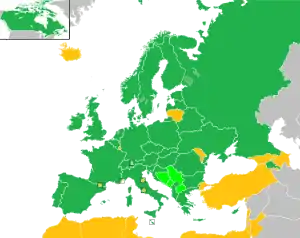
| Year | Country making its début entry |
|---|---|
| 1985 | |
| 1987 | |
| 1989 | |
| 1991 | |
| 1993 | |
| 1995 | |
| 1997 | |
| 1999 | |
| 2001 | |
| 2003 | |
| 2011 | |
| 2013 | |
| 2015 |
Hosting
Most of the expenses of the contest are covered by commercial sponsors and contributions from the other participating nations. The contest is considered to be a unique opportunity for promoting the host country as a tourist destination. The table below shows a list of cities and venues that have hosted Eurovision Young Dancers, one or more times. Future venues are shown in italics. With three contests, Poland is the country having hosted the most editions.[21]
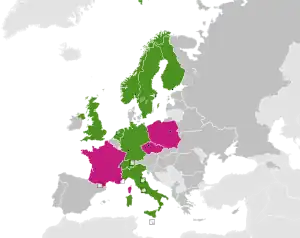
A single contest |
Multiple contests |
Winners
Sixteen performances have won the Eurovision Young Dancers competition. There have been fourteen editions, with each having a winner, second, and third places for all dance styles combined, with exception to the 1989 edition which awarded first place for contemporary and classical dance categories; and the 2003 edition which gave first place prizes for ballet, modern dance, and a 'Youth Jury Choice' categories. From 2011 onwards, there have only been prizes awarded to the winner and runner-up.[4] Below is a break-down of all those winners by individual event and by number of wins per country.
Winners by year
| Year | Date | Host City | Countries | Winner(s) | Performer(s) | Dance |
|---|---|---|---|---|---|---|
| 1985 | 16 June | 11 | Arantxa Argüelles | Unknown | ||
| 1987 | 31 May | 14 | Rose Gad Poulsen and Nikolaj Hübbe | Divertissement from "La Sylphide" | ||
| 1989 | 28 June | 17 | Agnès Letestu (Contemporary dance) | Unknown | ||
| Tetsuya Kumakawa (Classical ballet) | ||||||
| 1991 | 5 June | 15 | Amaya Iglesias | Variations from "La Grisi" | ||
| 1993 | 15 June | 15 | Zenaida Yanowsky | "Esmeralda" | ||
| 1995 | 6 June | 15 | Jesús Pastor Sahuquillo and Ruth Miró Salvador | "Arrayan Daraxa" | ||
| 1997 | 17 June | 13 | Antonio Carmena San José | "Angelitos Locos" | ||
| 1999 | 10 July | 16 | Stegli Yohan and Katja Wünsche | "Cinderella" | ||
| 2001 | 23 June | 18 | David Kupinski and Marcin Kupinski | "Brothers" | ||
| 2003 | 4 July | 17 | Jerlin Ndudi (Ballet) | "Le Corsaire" | ||
| Kristina Oom and Sebastian Michanek (Modern dance) | "Light Beings" | |||||
| Monika Hejduková and Viktor Konvalinka (Youth Jury Choice) | "The Twilight Of Innocence" | |||||
| 2005 | 24 June | 13 | Milou Nuyens | "Snakesense" | ||
| 2011 | 24 June | 10 | Daniel Sarr | "Full Force" | ||
| 2013 | 14 June | 10 | Sedrig Verwoert | "The 5th Element" | ||
| 2015 | 19 June | 10 | Viktoria Nowak | "Piece in Old Style" | ||
| 2017 | 16 December | 8 | Paulina Bidzińska | "La Certa" | ||
Winners by country
The table below shows the top-three placings from each contest, along with the years that a country won the contest.
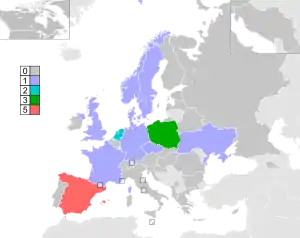
| Country | Total | Years won | |||
|---|---|---|---|---|---|
| 5 | 0 | 1 | 6 | ||
| 3 | 1 | 0 | 4 | ||
| 2 | 0 | 2 | 4 | ||
| 1 | 2 | 2 | 5 | ||
| 1 | 1 | 1 | 3 | ||
| 1 | 1 | 1 | 3 | ||
| 1 | 1 | 0 | 2 | ||
| 1 | 0 | 1 | 2 | ||
| 1 | 0 | 0 | 1 | ||
| 1 | 0 | 0 | 1 | ||
| 1 | 0 | 0 | 1 | ||
| 0 | 3 | 0 | 3 | — | |
| 0 | 2 | 2 | 4 | — | |
| 0 | 2 | 0 | 2 | — | |
| 0 | 1 | 0 | 1 | — | |
| 0 | 0 | 1 | 1 | — | |
| 0 | 0 | 1 | 1 | — |
Presenters
| Year | Presenter(s) | Backstage host |
|---|---|---|
| 1985 | Carla Fracci and Gheorghe Iancu | Not present |
| 1987 | Margot Werner | |
| 1989 | Zizi Jeanmaire and Alain Duault | |
| 1991 | Taina Elg and Heikki Värtsi | |
| 1993 | Anneli Alhanko and John Chrispinsson | |
| 1995 | Géraldine Chaplin and Jean-Pierre Pastori | |
| 1997 | Grażyna Torbicka and Bogusław Kaczyński (semi-final) Henk van der Meulen (final) | |
| 1999 | Alex Taylor | |
| 2001 | Deborah Bull | |
| 2003 | Aldith Hunkar | |
| 2005 | Agata Konarska | |
| 2011 | Erik Solbakken | |
| 2013 | Tomasz Kammel | Michael Nunn and William Trevitt |
| 2015 | Libor Bouček | Cameron McMillan |
| 2017 | Libor Bouček and Angeé Roučková | Not present |
See also
Notes and references
Notes
- ^ The European Broadcasting Area was expanded in November 2007 by the World Radiocommunication Conference (WRC-07), also to include Armenia, Azerbaijan and Georgia.[15][22]
- ^ The Eurovision Young Dancers 2007 would have taken place in Lausanne on the 4 February 2007. However, the competition was cancelled in a mutual decision between the European Broadcasting Union and Swiss broadcaster SRG SSR idée suisse, who both collaborated on the production of a similar dance competition, Prix de Lausanne, held in Lausanne. If the contest had taken place, then Lausanne and Switzerland would have hosted twice.[6]
- ^ The Eurovision Young Dancers 1989 event had two sets of first prize, one for contemporary dance (awarded to France) and one for classical dance (awarded to United Kingdom).[23]
- ^ The Eurovision Young Dancers 2003 event had three sets of first prize, one for modern dance (awarded to Sweden), one for ballet (awarded to Ukraine), and the 'Youth Jury Choice' (awarded to Czech Republic).[24]
References
- ↑ "Eurovision Young Dancers - Synopsis". ukgameshows.com. UK Games Shows. Retrieved 8 March 2015.
- ↑ "Eurovision Young Dancers". ebu.ch. European Broadcasting Union. Retrieved 8 March 2015.
- ↑ "1st Eurovision Young Dancers 1985". youngdancers.tv. European Broadcasting Union. Retrieved 8 March 2015.
- 1 2 3 "Eurovision Young Dancers - History by country". youngdancers.tv. European Broadcasting Union. Retrieved 8 March 2015.
- 1 2 "Canada in the Eurovision Young Dancers". youngdancers.tv. European Broadcasting Union. Retrieved 8 March 2015.
- 1 2 "Eurovision Young Dancers 2007". youngdancers.tv. European Broadcasting Union. Archived from the original on 2 April 2015. Retrieved 8 March 2015.
- ↑ "Eurovision Young Dancers 2009". eurovoix.com. Eurovoix. Retrieved 22 November 2016.
- ↑ "Eurovision Young Dancers revamped for prime time". Eurovision.tv. 2011-04-26. Retrieved 2015-03-05.
- ↑ "Update on Eurovision Young Dancers 2017". youngdancers.tv. European Broadcasting Union. 23 January 2017. Retrieved 25 January 2017.
- ↑ Granger, Anthony (18 May 2017). "Czech Republic: Confirmed as new host country of Eurovision Young Dancers 2017". eurovoix.com. Eurovoix. Retrieved 18 May 2017.
- ↑ Granger, Anthony (20 December 2018). "Eurovision Young Dancers 2019 Cancelled Due to Lack of Host Broadcaster". eurovoix.com. Retrieved 20 December 2018.
- ↑ Grace, Emily (13 October 2020). "Eurovision Young Dancers Will Not Return Next Year". Eurovoix.
- 1 2 "Eurovision Young Dancers - Format". youngdancers.tv. European Broadcasting Union. Archived from the original on 11 February 2015. Retrieved 8 March 2015.
- 1 2 "Membership conditions". European Broadcasting Union. Retrieved 3 February 2012.
- 1 2 "ITU-R Radio Regulations 2012-2015" (PDF). International Telecommunication Union, available from the Spectrum Management Authority of Jamaica. 2012. Archived from the original (PDF) on 16 August 2013. Retrieved 27 May 2013.
- ↑ "Radio Regulations". International Telecommunication Union. 8 September 2005. Retrieved 18 July 2006.
- ↑ "Kosovo in the Eurovision Young Dancers". youngdancers.tv. European Broadcasting Union. Retrieved 8 March 2015.
- ↑ "Cyprus in the Eurovision Young Dancers". youngdancers.tv. European Broadcasting Union. Retrieved 8 March 2015.
- ↑ "Armenia in the Eurovision Young Dancers". youngdancers.tv. European Broadcasting Union. Retrieved 8 March 2015.
- ↑ "Russia in the Eurovision Young Dancers". youngdancers.tv. European Broadcasting Union. Retrieved 8 March 2015.
- ↑ "Eurovision Young Dancers - History by year". youngdancers.tv. European Broadcasting Union. Retrieved 8 March 2015.
- ↑ "ITU-R Radio Regulations - Articles edition of 2004 (valid in 2004-2007)" (PDF). International Telecommunication Union. 2004. Archived from the original (PDF) on 2017-10-10. Retrieved 2015-03-08.
- ↑ "Eurovision Young Dancers 1989". youngdancers.tv. European Broadcasting Union. Retrieved 9 March 2015.
- ↑ "Eurovision Young Dancers 2003". youngdancers.tv. European Broadcasting Union. Retrieved 9 March 2015.